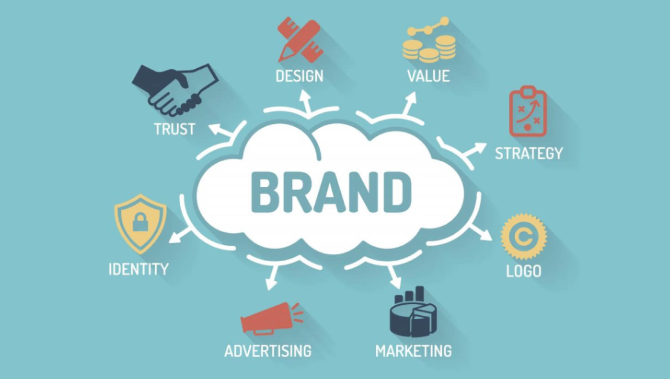Introduction
In today’s competitive market, a strong brand identity is essential for distinguishing your business from the crowd. It’s more than just a logo or a catchy tagline—it’s the essence of what your business represents and how it resonates with your audience. This guide will walk you through the steps to create a powerful brand identity that captivates your target market, builds trust, and drives long-term success.
What is Brand Identity?
Brand identity refers to the visible and emotional elements of a brand that influence how it’s perceived. It encompasses:
- Visual elements: Logo, colors, typography, and packaging.
- Voice and tone: The way you communicate with your audience.
- Core values and mission: What your brand stands for and its purpose.
A cohesive brand identity helps your business stand out and fosters a deeper connection with your audience.
1. Understanding Your Business and Audience
Define Your Mission and Vision
Your mission explains why your business exists, and your vision outlines what you aim to achieve in the future. A clear mission and vision serve as the foundation for your brand identity.
Know Your Target Audience
- Conduct market research to understand your audience’s needs, preferences, and pain points.
- Create customer personas to represent your ideal customers.
Assess Competitors
- Analyze competitors’ branding strategies to identify gaps and opportunities.
- Differentiate your brand by offering unique value.
2. Develop Your Brand’s Personality
Why Brand Personality Matters
A relatable and consistent personality makes your brand more memorable. Think of your brand as a person—what would their traits be?
Steps to Define Brand Personality
- List adjectives that describe your brand (e.g., innovative, friendly, trustworthy).
- Align these traits with your audience’s expectations.
- Use these traits consistently in your communications and marketing.
3. Craft a Memorable Logo
Importance of a Logo
Your logo is the face of your brand and often the first thing people notice.
Tips for Creating a Great Logo
- Keep it simple and versatile.
- Choose colors and fonts that reflect your brand personality.
- Hire a professional designer for high-quality results.
4. Establish a Cohesive Color Palette
Why Colors Matter
Colors evoke emotions and associations. Choosing the right palette enhances recognition and conveys your brand’s essence.
Tips for Choosing Colors
- Select 2-3 primary colors and 1-2 accent colors.
- Research color psychology to match colors with your brand values.
- Ensure accessibility by using contrasting colors for text and backgrounds.
5. Choose Typography That Reflects Your Brand
The Role of Typography
Fonts communicate subtle messages about your brand’s style and professionalism.
Typography Tips
- Use no more than 2-3 complementary fonts.
- Opt for legible fonts for web and print use.
- Match typography to your brand’s tone (e.g., modern, classic, playful).
6. Create a Compelling Brand Voice
What is Brand Voice?
Your brand voice is how you communicate with your audience across all platforms. It should reflect your personality and resonate with your target market.
How to Develop a Brand Voice
- Identify your tone (e.g., formal, conversational, humorous).
- Use consistent language and style in all communications.
- Document guidelines for your team to maintain uniformity.
7. Design Consistent Visual Assets
What Are Visual Assets?
These include business cards, brochures, website graphics, and social media visuals.
Tips for Consistency
- Use your brand’s colors, fonts, and logo in all materials.
- Invest in professional photography or illustrations.
- Ensure all assets align with your overall branding strategy.
8. Build a User-Friendly Website
Why Your Website Matters
Your website is often the first point of contact for potential customers. A well-designed site reflects your brand’s professionalism and credibility.
Key Website Elements
- Use your brand’s colors, typography, and visuals.
- Write copy that reflects your brand voice.
- Optimize for mobile and ensure fast loading speeds.
9. Leverage Social Media
Social Media and Branding
Social platforms amplify your brand’s reach and engagement.
Best Practices
- Maintain consistent branding across all platforms.
- Share content that aligns with your brand values.
- Interact with your audience to humanize your brand.
10. Tell Your Brand Story
Why Storytelling Works
A compelling story connects emotionally with your audience and builds trust.
Elements of a Good Brand Story
- Highlight your business’s origins, challenges, and milestones.
- Showcase how your products or services solve customer problems.
- Use storytelling in marketing campaigns and content.
11. Ensure Consistency Across All Channels
Why Consistency is Key
Consistency strengthens recognition and trust.
How to Stay Consistent
- Develop a brand style guide.
- Regularly audit your branding across platforms.
- Train your team to follow branding guidelines.
12. Adapt and Evolve Your Brand Identity
When to Update Your Brand
As your business grows, your brand identity may need adjustments to remain relevant.
How to Refresh Your Brand
- Reevaluate your mission, audience, and market trends.
- Update visual elements and messaging to align with new goals.
- Maintain core elements to preserve recognition.
13. Measure Your Brand’s Success
Why Metrics Matter
Tracking performance helps you identify strengths and areas for improvement.
Key Metrics to Monitor
- Brand recognition and recall.
- Customer engagement and feedback.
- Sales and revenue growth linked to branding efforts.
14. Examples of Strong Brand Identities
Apple
Known for simplicity, innovation, and premium quality, Apple’s branding is consistently reflected in its products, advertising, and packaging.
Nike
Nike’s “Just Do It” slogan and empowering storytelling resonate with athletes and fitness enthusiasts worldwide.
15. Common Mistakes to Avoid
Mistakes to Watch For
- Copying competitors instead of standing out.
- Overcomplicating your logo or visuals.
- Inconsistent messaging across channels.
How to Avoid Them
- Focus on authenticity and originality.
- Test branding elements with your target audience.
- Regularly update your brand strategy.
Conclusion
Creating a strong brand identity is a journey that requires thought, effort, and consistency. By defining your mission, understanding your audience, and using cohesive visual and verbal elements, you can craft a brand that stands out and fosters lasting customer loyalty. A well-executed brand identity doesn’t just build recognition—it creates an emotional connection that drives growth and success.
FAQs
1. Why is brand identity important for small businesses?
Brand identity sets your business apart from competitors, builds trust, and helps attract and retain customers.
2. How can I ensure my brand identity stays consistent?
Develop a brand style guide and regularly audit your branding across all channels.
3. What’s the difference between a logo and a brand identity?
A logo is a visual symbol, while brand identity includes all elements—visual and emotional—that define your brand.
4. How often should I update my brand identity?
Review your brand identity every few years or when there are significant changes in your business goals or market.
5. Can I create a strong brand identity on a tight budget?
Yes! Focus on understanding your audience, using free design tools, and staying consistent with your branding efforts.

